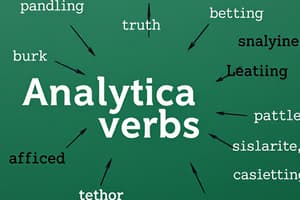Podcast
Questions and Answers
What are the common sections in the structure of an analytical paragraph?
What are the common sections in the structure of an analytical paragraph?
Topic sentence, supporting evidence, analysis, conclusion
What is the main purpose of a topic sentence in an analytical paragraph?
What is the main purpose of a topic sentence in an analytical paragraph?
Introduce the central idea of the paragraph and provide an outline of what to expect
What role does supporting evidence play in an analytical paragraph?
What role does supporting evidence play in an analytical paragraph?
Strengthening the argument
How is analysis typically carried out in an analytical paragraph?
How is analysis typically carried out in an analytical paragraph?
What is the function of the conclusion in an analytical paragraph?
What is the function of the conclusion in an analytical paragraph?
Why is the connection between paragraphs important when composing multiple analytical paragraphs?
Why is the connection between paragraphs important when composing multiple analytical paragraphs?
What is the purpose of topic sentences in analytical paragraphs?
What is the purpose of topic sentences in analytical paragraphs?
How does supporting evidence contribute to the credibility of an argument?
How does supporting evidence contribute to the credibility of an argument?
What is the role of analysis in analytical writing?
What is the role of analysis in analytical writing?
Why is it important to avoid relying solely on one method of analysis?
Why is it important to avoid relying solely on one method of analysis?
How do conclusions contribute to the coherence of analytical paragraphs?
How do conclusions contribute to the coherence of analytical paragraphs?
What is the overall benefit of mastering the craft of analytical paragraphs?
What is the overall benefit of mastering the craft of analytical paragraphs?
Flashcards are hidden until you start studying
Study Notes
Understanding Analytical Paragraphs
Analytical paragraphs are an essential component of writing where you dissect, examine, interpret, and present your findings regarding a specific subject or idea. In this guide, we'll explore the structure, importance, and key elements of an effective analytical paragraph.
Structure of Analytical Paragraphs
An analytical paragraph typically follows a logical flow with these common sections:
- A clear and concise topic sentence stating the main point you wish to address within the paragraph.
- Supporting evidence, such as facts, examples, statistics or quotes from relevant sources, which help strengthen your argument.
- An examination of how individual pieces of evidence relate to each other and support your overall thesis through analysis. This is often accomplished by comparing and contrasting different aspects of the subject matter.
- A brief summary or restatement of your central message known as the conclusion.
The connection between paragraphs becomes more important when composing multiple analytical paragraphs, ensuring they build off one another rather than repeating information or contradicting previous arguments.
Topic Sentences
Topic sentences play a crucial role in an analytical paragraph as they serve two purposes: they introduce the central idea of the paragraph and provide readers with an outline of what to expect within it. These sentences must contain enough specific detail to convey a clear meaning without going too broad and losing focus. They also function as hooks that keep readers engaged throughout the paragraph, prompting them to continue reading for further explanation.
Supporting Evidence
As mentioned earlier, providing reliable evidence helps lend credibility and depth to your argument. Select relevant and accurate data or information depending upon your subject, audience, and desired level of complexity. Ensure all citations follow appropriate citation styles applicable to your field or discipline. If possible, arrange related items together to make connections among various points evident to both you and your reader.
Analysis
Analysis goes beyond merely presenting ideas; instead, it involves drawing relationships between the material presented and interpreting their significance in context. To illustrate connections effectively, it might be beneficial to employ techniques like comparison, contrast, cause-and-effect, and classification. However, avoid solely relying on these methods because doing so could lead to repetitive patterns and lackluster results. Instead, try combining several approaches to create a multifaceted perspective while avoiding redundancy.
Conclusions
Conclusions summarize the primary points discussed within a paragraph and reinforce the relationship between components of your analysis. They can either repeat the narrative or synthesize information into a broader statement, leaving readers with something meaningful to mull over after finishing the text. Additionally, conclusions set up smooth transitions to subsequent paragraphs if necessary, consolidating cohesiveness across larger works.
In summation, understanding the intricate workings and purposeful construction of analytical paragraphs facilitates better communication of concepts and provides opportunities for deeper learning experiences. By mastering the craft, analysts can engage audiences while putting forward compelling, well-structured, and thoroughly supported claims.
Studying That Suits You
Use AI to generate personalized quizzes and flashcards to suit your learning preferences.




